By SONG Jianlan (Staff Reporter)
All this began with a call for help.
On August 21,2013, Prof. YANG Min, researcher at the Research Center for Eco-Environmental Sciences (RCEES) under the Chinese Academy of Sciences (CAS), received an email from Dr. Sujithra Weragoda, the National Water Supply and Drainage Board of Sri Lanka.
In his email, Dr. Weragoda described a kind of chronic kidney disease (CKD) prevalent in North Central Province (NCP) and the neighboring areas, whose cause was unknown. Judging from what he learnt at a training course of water and sanitation held by RCEES, CAS in 2012, he wondered if technologies from RCEES for water purification could help overcome the plight and improve the health of local people.
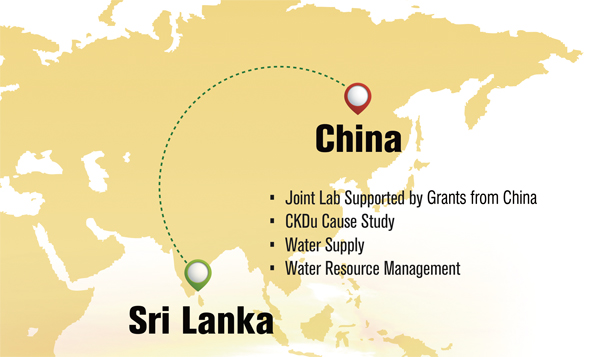
Horrible Disease
Named by experts as “chronic kidney disease of uncertain etiology (CKDu),” the disease Dr. S.K. Weragoda described occurred much more frequently in the mentioned region than other parts of Sri Lanka. This type of CKD accounts for over 70% of all CKD cases in the affected region; among local people aged between 15 and 70, 15.1% to 22.9% suffered from this disease. In a sharp contrast, the occurrence rate in other regions is as low as 0.2%. In 2016, about 180 thousand cases were reported, calling a death toll of about 50 thousand.
CKDu patients suffer from a series of discomforts, including dysuria, pains in the waist and back, and proteinuria. At the end-stage of the disease, it could develop into renal failure, leading to death.
What makes it even more horrible is, at the beginning the patients might feel no obvious symptom, until very late – at the point of diagnosis it could have already developed and deeply ingrained to an incurable extent. This makes it very hard to track its causes and hence very challenging to contain or prevent the disease. First reported in Sri Lanka as early as in the 1990s, so far its causes are still not fully identified.
Dr. Weragoda’s email worried YANG and his colleagues. They made a long journey into Sri Lanka, conducting local field investigations to track potential causes of the disease, and conducting experimental projects aimed at improving water supply in the CKDu affected areas.
Tracking the Potential Causes
Previous investigations made by WHO and other international organizations indicated that this strange disease might be caused by a combination of various factors, including contaminants and toxins from the environment, and life style. Possible contaminants might include farming chemicals like pesticides and herbicides; heavy metals like cadmium, arsenic and lead; and some special toxins from herbal medicines like aristolochic acid, which can be easily found in Asian traditional medicine and even local diet.
Long-time intake of tobacco or low-quality wines could also contribute to the occurrence.

The abnormally high occurrence of CKDu in the stricken region could have some connection with the hardness of ground water available in local communities. (Photo by courtesy of RCEES)
“Combining data obtained in our investigation and published literature, including reports released by WHO,” said Prof. WEI Yuansong, researcher at RCEES, CAS in charge of the investigations and water purification projects in Sri Lanka, “the abnormally high occurrence of this disease in the region could have some connection with the hardness of ground water available in local communities.” The range of CKDu-stricken area coincides well with that of the area where hard water prevails, he introduced, showing the author a chart comparing the two.

Prof. YANG Min (center) and his RCEES colleagues at fieldwork investigating the infrastructure for water supply in North Central Province of Sri Lanka. (Photo by courtesy of RCEES)
Another important reason, he continued, might be the hot weather in the dry region. This deprives fluids from the body, and in the long run could hurt the kidney.
At present, said Dr. MENG Liqiang, expert from the Peking University First Hospital (PKUFH), the academic community tends to agree that hot weather, repeated dehydration and intense manual work all contribute to acute renal injury (AKI). “Hard working physically in hot temperature can cause serious dehydration. This on the one hand can weaken the resilience of the body against high temperature, on the other can raise the risks of renal failure,” he introduced when asked about the possible mechanism.
MENG has been in cooperation with Prof. WEI to track the cause of CKDu in Sri Lanka. On top of hot weather and dehydration, he furthered, toxins in low-quality water supply can doubly hurt the kidney. “Repeatedly occurring AKI might cause CKD; and after long incubation chronic renal failure could follow. Still, however, the connection needs further research to establish,” he analyzed.
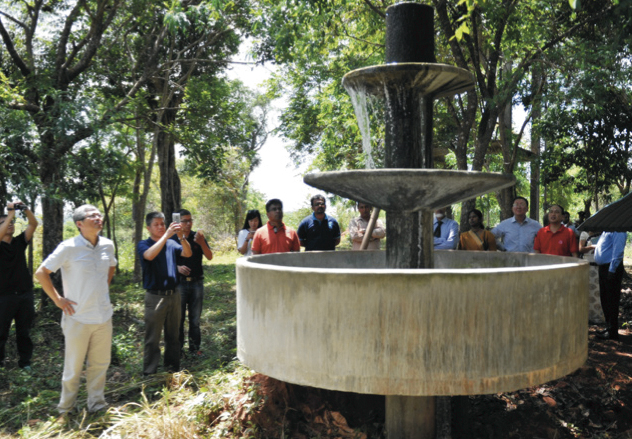
The poor quality of well water, which dominated local water supply, is understood as a possible source in connection with the disease. (Photo by courtesy of RCEES)
In their field investigations, YANG and WEI’s team discovered that the major source of water supply in the region was well water, and the infrastructure was too poor to secure its sanitation. “As much as 46% water was supplied by wells there, and the technology available there for quality analysis and monitoring is outdated,” he said with worries. “The technique could barely identify a fraction of organic contaminants, and essentially no inorganic ones.”
This situation prompted the idea to treat the well water with advanced water treatment technologies such as electrodialysis reversal (ED) and nanofiltration (NF) membrane technologies to improve water supply for local people.
“The improved water supply means a lot to local people,” said WEI and MENG, “This not only might help mitigate the plight of CKDu, but also other diseases prevalent.”
“This might also help further the research in quest for the causes of CKDu,” affirmed MENG. “After all, through comparing the occurrence rates before and after the replacement, or the same indices of the beneficiary communities and others, we might be able to establish the connection between certain contaminants in the water and the occurrence.”
Given the importance of water supply for the welfare of local people and its potential role in prevention and mitigation of the disease, YANG and WEI decided to offer technological support and build some demonstrative water purifying projects in the local communities, to help improve the quality of water supply, and at the same time improve the local capacity of water technology.
Benefiting Local Communities
To tackle the disease, YANG and WEI offered a comprehensive solution, targeted at different aspects of the issue to hit the goal.
First of all, they decided to erect some small water-supply projects to replace the well water in some communities. This plan won the support from the local government, and started to take effect.
A set of ED facility developed by RECEES was soon set up in Kahatagasdigeliya, Anuradhapura of NCP, a small community of about 1,500 people. Capable of softening ground water and meanwhile removing toxic fluorine and nitrate from it, every day this device can produce about 300 tons of clean fresh water. So far it has been operating smoothly, having produced about 20 thousand tons of fresh water for the local residents.
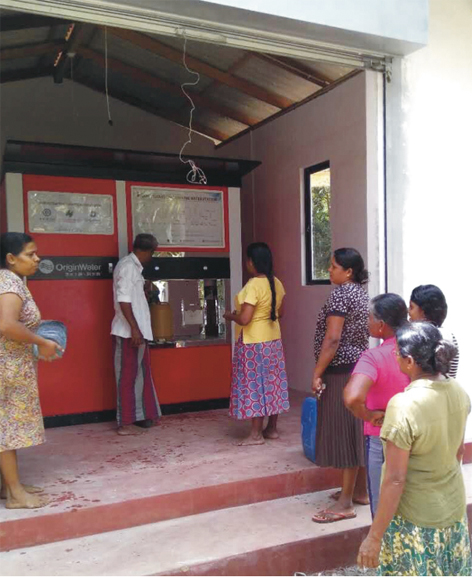
Residents in Rajanganaya queuing for clean, sanitary drinking water at the water supplying device built by RCEES. Equipped with water technology developed by RCEES, the device was put into operation in September 2018, with a capacity of 20m3/d clean drinking water for the 164 households (about 750 persons) there.(Photo by courtesy of RCEES)
Other demonstrative projects, of different scales, such as NF drinking water station at the capacity of 20m3/d, have launched in several other communities.
YANG’s team also started some projects to collect and purify rainwater for some CKDu patient families and organizations, including a school.

The rainwater collected by the pipelines will arrive at a tank where the water undergoes purification. (Photo by courtesy of RCEES)
“Rain water is soft water; and our technology of harvesting and purification can secure its safety and sanitation,” said WEI, “therefore this could be a good solution for providing clean water supply of decentralized rural villages.”

The kids at the school now benefit from the rain-water harvesting and purifying project. (Photo by courtesy of RCEES)
To secure a sustainable improvement in water quality, they also took a series of measures to help build up local capacity in water technology. Moreover, they join hands with PKUFH and the Beijing Centers for Disease Control (CDC) to investigate the causes of CKDu and conduct epidemiological survey. The cooperators have also offered a hand to provide training opportunities on disease diagnosis and medical care.
“There are only about two dozen kidney doctors in Sri Lanka, while in Beijing, on the campus of PKUFH alone, you can find over 50,” said WEI. “Therefore, we can offer some help in human capacity building through training local medical professionals.”

Trainees on a lab tour during the first training course for nephrology medical care techniques occurring from October to December 2017. So far such training has been held twice in Beijing. (Photo by courtesy of RCEES)
For this sake, Sri Lanka trainees are invited to China for nephrology training, in support of scholarships granted by the CAS-TWAS Center of Excellence for Water and Environment (CEWE) headed by Prof. YANG. Since 2017, such training has been held twice in Beijing. Training for epidemiological survey of CKDu has also kicked off, with the first session successfully held in late spring 2018 in Beijing.
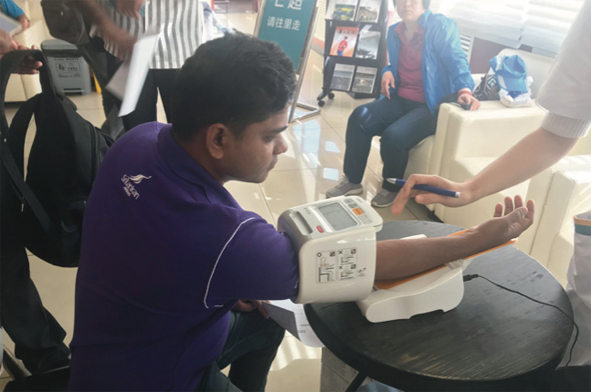
Sri Lanka trainees at a training course for epidemiological survey of CKDu in Beijing, occurring in May and June 2018. (Photo by courtesy of RCEES)
At the same time, research in quest for the causes of CKDu is on going. “Clearly identifying the causes of this disease will greatly benefit the local residents, and might encourage some change in lifestyle there,” commented MENG. “More importantly, this might provide a valuable reference for the prevention of CKDu in other areas and countries, inspiring development of diagnosis and treatment for this disease,” he continued.
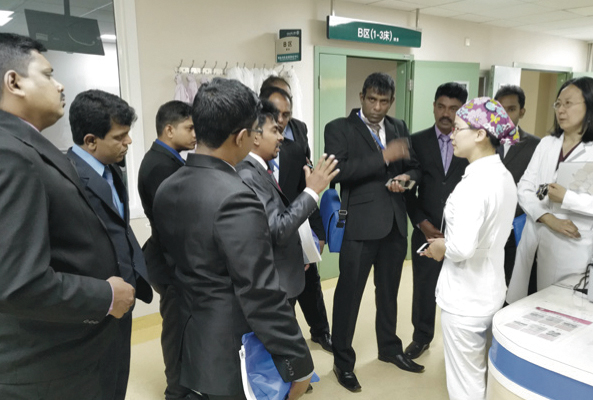
Trainees on a visit tour to the Peking University First Hospital. (Photo by courtesy of RCEES)
Outlook
Now YANG, WEI and their cooperators are expecting a new water-technology entity rising on the horizon of NCP.
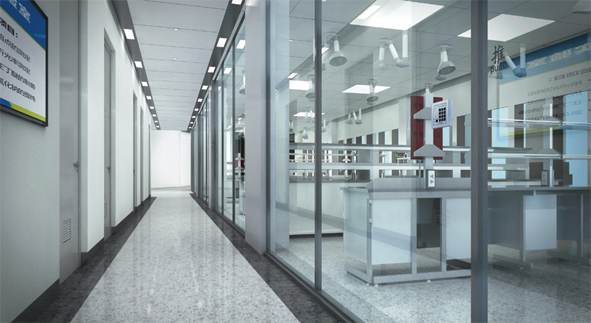
The lab for water quality analysis situated in the China-Sri Lanka Joint Water Center as designed. (Photo by courtesy of RCEES)
On November 21, 2017, the governments of China and Sri Lanka signed an implementation agreement to establish a Joint Research and Demonstration Center for Water Technology on the campus of the University of Peradeniya, the top university of Sri Lanka, which has maintained close partnership with RCEES and CEWE.
The construction is expected to complete by June 1, 2020. Currently, a temporary lab for water quality analysis and monitoring has filled the gap for urgent needs. It was unveiled on December 23, 2016, and has since been serving the local people.

The design of the China-Sri Lanka Joint Research and Demonstration Center for Water Technology. (Photo by courtesy of RCEES)

